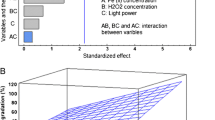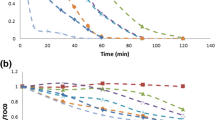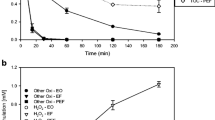Abstract
This work studies the degradation of seven representative antibiotics (ciprofloxacin, norfloxacin, levofloxacin, oxacillin, cloxacillin, cefalexin, and cefadroxil) by solar photo-Fenton process. The removal of antibiotics by the individual components (i.e., light, H2O2, or Fe (II)) and the complete photochemical system (light/H2O2/Fe (II)) was initially evaluated. Then, the effect of citric acid addition to the photo-Fenton system was assessed. In the third place, the primary transformation products for two illustrative cases (ciprofloxacin and oxacillin treated by photo-Fenton) were determined. Also, photo-Fenton in the presence of citric acid was applied to remove antibiotics from a simulated hospital wastewater. It was found that the solar light component induced degradation of ciprofloxacin, norfloxacin, and levofloxacin, but the rest of the considered antibiotics were not reduced by photolysis. In turn, the photo-Fenton system showed a degrading action on all the tested antibiotics. The addition of citric acid to the system significantly increased the removal of antibiotics. Initial degradation products indicated that hydroxyl radical attacked moieties of antibiotics responsible for their antimicrobial activity. Finally, the treatment of hospital wastewater evidenced the high potentiality of photo-Fenton process for degrading antibiotics in aqueous matrices containing elevated concentrations of citric acid.



Similar content being viewed by others
References
Abrahamson HB, Rezvani AB, Brushmiller JG (1994) Photochemical and spectroscopic studies of complexes, of iron (III) with citric acid and other carboxylic acids. Inorg Chim Acta 226:117–127. https://doi.org/10.1016/0020-1693(94)04077-X
Ahmad I, Bano R, Sheraz MA, Ahmed S, Mirza T, Ansari SA (2013) Photodegradation of levofloxacin in aqueous and organic solvents: a kinetic study. Acta Pharma 63:223–229. https://doi.org/10.2478/acph-2013-0011
Albini A, Monti S (2003) Photophysics and photochemistry of fluoroquinolones. Chem Soc Rev 32:238–250. https://doi.org/10.1039/b209220b
Alovero FL, Pan X, Morris JE et al (2000) Engineering the specificity of antibacterial fluoroquinolones: benzenesulfonamide modifications at C-7 of ciprofloxacin change its primary target in Streptococcus pneumoniae from topoisomerase IV to gyrase. Antimicrob Agents Chemother 44:320–325. https://doi.org/10.1128/AAC.44.2.320-325.2000
An T, Yang H, Li G, Song W, Cooper WJ, Nie X (2010a) Kinetics and mechanism of advanced oxidation processes (AOPs) in degradation of ciprofloxacin in water. Appl Catal B Environ 94:288–294. https://doi.org/10.1016/j.apcatb.2009.12.002
An T, Yang H, Song W, Li G, Luo H, Cooper WJ (2010b) Mechanistic considerations for the advanced oxidation treatment of fluoroquinolone pharmaceutical compounds using TiO2 heterogeneous catalysis. J Phys Chem A 114:2569–2575. https://doi.org/10.1021/jp911349y
Andersson MI, MacGowan AP (2003) Development of the quinolones. J Antimicrob Chemother 51(Suppl 1):1–11. https://doi.org/10.1093/jac/dkg212
Armstrong DA, Huie RE, Lymar S, Koppenol WH, Merényi G, Neta P, Stanbury DM, Steenken S, Wardman P (2013) Standard electrode potentials involving radicals in aqueous solution: inorganic radicals. Bioinorg React Mech 9:59–61. https://doi.org/10.1515/irm-2013-0005
Bacardit J, Stötzner J, Chamarro E, Esplugas S (2007) Effect of salinity on the photo-Fenton process. Ind Eng Chem Res 46:7615–7619. https://doi.org/10.1021/ie070154o
Bansal P, Verma A (2017) Synergistic effect of dual process (photocatalysis and photo-Fenton) for the degradation of Cephalexin using TiO2 immobilized novel clay beads with waste fly ash/foundry sand. J Photochem Photobiol A Chem 342:131–142. https://doi.org/10.1016/j.jphotochem.2017.04.010
BCRenal Agency (2016) Cleaning & disinfecting Hemodialysis machines & stations. BCRenal Agency Canada
Botero-Coy AM, Martínez-Pachón D, Boix C, Rincón RJ, Castillo N, Arias-Marín LP, Manrique-Losada L, Torres-Palma R, Moncayo-Lasso A, Hernández F (2018) An investigation into the occurrence and removal of pharmaceuticals in Colombian wastewater. Sci Total Environ 642:842–853. https://doi.org/10.1016/j.scitotenv.2018.06.088
Brausch JM, Connors K, Brooks BW, Rand GM (2012) Human pharmaceuticlas in the aquatic environment: a review of recent toxicological studies and considerations for toxicity testing. Rev Environ Contam Toxicol 218:1–99. https://doi.org/10.1007/978-1-4614-3137-4
Buitrago JL, Sanabria J, Gútierrez-Zapata HM, Urbano-Ceron FJ, García-Barco A, Osorio-Vargas P, Rengifo-Herrera JA (2020) Photo-Fenton process at natural conditions of pH, iron, ions, and humic acids for degradation of diuron and amoxicillin. Environ Sci Pollut Res 27:1608–1624. https://doi.org/10.1007/s11356-019-06700-y
Clarizia L, Russo D, Di Somma I et al (2017) Environmental homogeneous photo-Fenton processes at near neutral pH : a review. Appl Catal B Environ Environ 209:358–371. https://doi.org/10.1016/j.apcatb.2017.03.011
Cornelisse J, Havinga E (1975) Photosubstitution reactions of aromatic compounds. Chem Rev 75:353–388. https://doi.org/10.1021/cr60296a001
Dail MK, Mezyk SP (2010) Hydroxyl-radical-induced degradative oxidation of beta-lactam antibiotics in water: absolute rate constant measurements. J Phys Chem A 114:8391–8395. https://doi.org/10.1021/jp104509t
De la Cruz N, Giménez J, Esplugas S et al (2012) Degradation of 32 emergent contaminants by UV and neutral photo-fenton in domestic wastewater effluent previously treated by activated sludge. Water Res 46:1947–1957. https://doi.org/10.1016/j.watres.2012.01.014
De la Cruz N, Esquius L, Grandjean D et al (2013) Degradation of emergent contaminants by UV, UV/H2O2 and neutral photo-Fenton at pilot scale in a domestic wastewater treatment plant. Water Res 47:5836–5845. https://doi.org/10.1016/j.watres.2013.07.005
De Lima Perini JA, Perez-Moya M, Nogueira RFP (2013) Photo-Fenton degradation kinetics of low ciprofloxacin concentration using different iron sources and pH. J Photochem Photobiol A Chem 259:53–58. https://doi.org/10.1016/j.jphotochem.2013.03.002
de Lima Perini JA, Costa e Silva BC, Tonetti AL et al (2017) Photo-Fenton degradation of the pharmaceuticals ciprofloxacin and fluoxetine after anaerobic pre-treatment of hospital effluent. Environ Sci Pollut Res 24:6233–6240. https://doi.org/10.1007/s11356-016-7416-4
Devi LG, Munikrishnappa C, Nagaraj B, Rajashekhar KE (2013) Effect of chloride and sulfate ions on the advanced photo Fenton and modified photo Fenton degradation process of Alizarin Red S. J Mol Catal A Chem 374–375:125–131. https://doi.org/10.1016/j.molcata.2013.03.023
Domagala JM (1994) Structure-activity and structure-side-effect relationships for the quinolone antibacterials. J Antimicrob Chemother 33:685–706. https://doi.org/10.1093/jac/33.4.685
Elmolla E, Chaudhuri M (2009) Degradation of the antibiotics amoxicillin , ampicillin and cloxacillin in aqueous solution by the photo-Fenton process. J Hazard Mater 172:1476–1481. https://doi.org/10.1016/j.jhazmat.2009.08.015
Fasani E, Barberis Negra FF, Mella M, Monti S, Albini A (1999) Photoinduced C-F bond cleavage in some fluorinated 7-amino-4-quinolone- 3-carboxylic acids. J Organomet Chem 64:5388–5395. https://doi.org/10.1021/jo982456t
Ge L, Chen J, Wei X, Zhang S, Qiao X, Cai X, Xie Q (2010) Aquatic photochemistry of fluoroquinolone antibiotics: kinetics, pathways, and multivariate effects of main water constituents. Environ Sci Technol 44:2400–2405. https://doi.org/10.1021/es902852v
Giannakis S, Polo López MI, Spuhler D et al (2016) Solar disinfection is an augmentable, in situ-generated photo-Fenton reaction-part 2: a review of the applications for drinking water and wastewater disinfection. Appl Catal B Environ 198:431–446. https://doi.org/10.1016/j.apcatb.2016.06.007
Giraldo-Aguirre AL, Erazo-Erazo ED, Flórez-Acosta OA, Serna-Galvis EA, Torres-Palma RA (2015) TiO2 photocatalysis applied to the degradation and antimicrobial activity removal of oxacillin: evaluation of matrix components, experimental parameters, degradation pathways and identification of organics by-products. J Photochem Photobiol A Chem 311:95–103. https://doi.org/10.1016/j.jphotochem.2015.06.021
Giraldo-Aguirre AL, Serna-Galvis EA, Erazo-Erazo ED, Silva-Agredo J, Giraldo-Ospina H, Flórez-Acosta OA, Torres-Palma RA (2018) Removal of β-lactam antibiotics from pharmaceutical wastewaters using photo-Fenton process at near-neutral pH. Environ Sci Pollut Res 25:20293–20303. https://doi.org/10.1007/s11356-017-8420-z
Gomes Júnior O, Silva VM, Machado AEH, Sirtori C, Lemos CR, Freitas AM, Trovó AG (2018) Correlation between pH and molar iron/ligand ratio during ciprofloxacin degradation by photo-Fenton process: identification of the main transformation products. J Environ Manag 213:20–26. https://doi.org/10.1016/j.jenvman.2018.02.041
Gothwal R, Shashidhar T (2015) Antibiotic pollution in the environment : a review. Clean - Soil Air Water 43:479–489. https://doi.org/10.1002/clen.201300989
Gringauz A (1997) Antimicrobial drugs I. In: Introduction to medicinal chemistry, First. Wiley-VCH, New York, pp 191–263
Hamm RE, Shull CM, Grant DM (1954) Citrate complexes with iron(II) and iron(III)1. J Am Chem Soc 76:2111–2114. https://doi.org/10.1021/ja01637a021
Hayyan M, Hashim MA, Alnashef IM (2016) Superoxide ion: generation and chemical implications. Chem Rev 116:3029–3085. https://doi.org/10.1021/acs.chemrev.5b00407
He X, Mezyk SP, Michael I, Fatta-Kassinos D, Dionysiou DD (2014) Degradation kinetics and mechanism of β-lactam antibiotics by the activation of H2O2 and Na2S2O8 under UV-254nm irradiation. J Hazard Mater 279:375–383. https://doi.org/10.1016/j.jhazmat.2014.07.008
Hernández F, Ibáñez M, Botero-Coy A-M, Bade R, Bustos-López MC, Rincón J, Moncayo A, Bijlsma L (2015) LC-QTOF MS screening of more than 1,000 licit and illicit drugs and their metabolites in wastewater and surface waters from the area of Bogotá, Colombia. Anal Bioanal Chem 407:6405–6416. https://doi.org/10.1007/s00216-015-8796-x
Homem V, Santos L (2011) Degradation and removal methods of antibiotics from aqueous matrices – a review. J Environ Manag 92:2304–2347. https://doi.org/10.1016/j.jenvman.2011.05.023
Khetan SK, Collins TJ (2007) Human pharmaceuticals in the aquatic environment: a challenge to green chemistry. Chem Rev 107:2319–2364. https://doi.org/10.1021/cr020441w
Klamerth N, Rizzo L, Malato S, Maldonado MI, Agüera A, Fernández-Alba AR (2010) Degradation of fifteen emerging contaminants at ug L-1 initial concentrations by mild solar photo-Fenton in MWTP effluents. Water Res 44:545–554. https://doi.org/10.1016/j.watres.2009.09.059
Klamerth N, Malato S, Agüera A, Fernández-Alba A (2013) Photo-Fenton and modified photo-Fenton at neutral pH for the treatment of emerging contaminants in wastewater treatment plant effluents: a comparison. Water Res 47:833–840. https://doi.org/10.1016/j.watres.2012.11.008
Konaklieva M (2014) Molecular targets of β-lactam-based antimicrobials: beyond the usual suspects. Antibiotics 3:128–142. https://doi.org/10.3390/antibiotics3020128
Kümmerer K (2009) Antibiotics in the aquatic environment – a review – part I. Chemosphere 75:417–434. https://doi.org/10.1016/j.chemosphere.2008.11.086
Liao C, Kang S-F, Wu F-A (2001) Hydroxyl radical scavenging role of chloride and bicarbonate ions in the H2O2/UV process. Chemosphere 44:1193–1200. https://doi.org/10.1016/S0045-6535(00)00278-2
Liu X, Yang D, Zhou Y, Zhang J, Luo L, Meng S, Chen S, Tan M, Li Z, Tang L (2017) Electrocatalytic properties of N-doped graphite felt in electro-Fenton process and degradation mechanism of levofloxacin. Chemosphere 182:306–315. https://doi.org/10.1016/j.chemosphere.2017.05.035
Magureanu M, Piroi D, Mandache NB, David V, Medvedovici A, Bradu C, Parvulescu VI (2011) Degradation of antibiotics in water by non-thermal plasma treatment. Water Res 45:3407–3416. https://doi.org/10.1016/j.watres.2011.03.057
Mandal S (2018) Reaction rate constants of hydroxyl radicals with micropollutants and their significance in advanced oxidation processes. J Adv Oxid Technol 21:178–195. https://doi.org/10.26802/jaots.2017.0075
Márquez G, Rodríguez EM, Beltrán FJ, Álvarez PM (2013) Determination of rate constants for ozonation of ofloxacin in aqueous solution. Ozone Sci Eng 35:186–195. https://doi.org/10.1080/01919512.2013.771530
Martinez JL (2009) Environmental pollution by antibiotics and by antibiotic resistance determinants. Environ Pollut 157:2893–2902. https://doi.org/10.1016/j.envpol.2009.05.051
Morgan B, Lahav O (2007) The effect of pH on the kinetics of spontaneous Fe(II) oxidation by O2 in aqueous solution – basic principles and a simple heuristic description. Chemosphere 68:2080–2084. https://doi.org/10.1016/j.chemosphere.2007.02.015
Niu X-Z, Busetti F, Langsa M, Croué J-P (2016) Roles of singlet oxygen and dissolved organic matter in self-sensitized photo-oxidation of antibiotic norfloxacin under sunlight irradiation. Water Res 106:214–222. https://doi.org/10.1016/j.watres.2016.10.002
Nogueira AA, Souza BM, Dezotti MWC, Boaventura RAR, Vilar VJP (2017) Ferrioxalate complexes as strategy to drive a photo-FENTON reaction at mild pH conditions: a case study on levofloxacin oxidation. J Photochem Photobiol A Chem 345:109–123. https://doi.org/10.1016/j.jphotochem.2017.05.020
Oller I, Gernjak W, Maldonado MI (2006) Solar photocatalytic degradation of some hazardous water-soluble pesticides at pilot-plant scale. J Hazard Mater 138:507–517. https://doi.org/10.1016/j.jhazmat.2006.05.075
Paul T, Dodd MC, Strathmann TJ (2010) Photolytic and photocatalytic decomposition of aqueous ciprofloxacin: transformation products and residual antibacterial activity. Water Res 44:3121–3132. https://doi.org/10.1016/j.watres.2010.03.002
Peterson LR (2001) Quinolone molecular structure-activity relationships: what we have learned about improving antimicrobial activity. Clin Infect Dis 33:S180–S186. https://doi.org/10.1086/321846
Petri BG, Watts RJ, Teel AL, et al (2011) Fundamentals of ISCO using hydrogen peroxide. In: Siegrist RL et al. (ed) In situ chemical oxidation for groundwater remediation. Springer Science + Business Media, pp 33–87
Pignatello JJ, Oliveros E, Mackay A (2006) Advanced oxidation processes for organic contaminant destruction based on the Fenton reaction and related chemistry. Crit Rev Environ Sci Technol 36:1–84. https://doi.org/10.1080/10643380500326564
Pouran SR, Aziz ARA, Mohd W, Wan A (2015) Review on the main advances in photo-Fenton oxidation system for recalcitrant wastewaters. J Ind Eng Chem 21:53–69. https://doi.org/10.1016/j.jiec.2014.05.005
Puddoo H, Nithyanandam R, Nguyenhuynh T (2017) Degradation of the antibiotic ceftriaxone by Fenton oxidation process and compound analysis. J Phys Sci 28:95–114. https://doi.org/10.21315/jps2017.28.3.7
Qian Y, Gao P, Xue G, Liu Z, Chen J (2018) Oxidation of cefalexin by permanganate: reaction kinetics, mechanism, and residual antibacterial activity. Molecules 23:2015. https://doi.org/10.3390/molecules23082015
Rivera-Utrilla J, Sánchez-Polo M, Ferro-García MÁ, Prados-Joya G, Ocampo-Pérez R (2013) Pharmaceuticals as emerging contaminants and their removal from water. A review. Chemosphere 93:1268–1287. https://doi.org/10.1016/j.chemosphere.2013.07.059
Rizzo L, Manaia C, Merlin C, Schwartz T, Dagot C, Ploy MC, Michael I, Fatta-Kassinos D (2013) Urban wastewater treatment plants as hotspots for antibiotic resistant bacteria and genes spread into the environment: a review. Sci Total Environ 447:345–360. https://doi.org/10.1016/j.scitotenv.2013.01.032
Salma A, Thoröe-boveleth S, Schmidt TC, Tuerk J (2016) Dependence of transformation product formation on pH during photolytic and photocatalytic degradation of ciprofloxacin. J Hazard Mater 313:49–59. https://doi.org/10.1016/j.jhazmat.2016.03.010
Sawyer DT, Valentine JS (1981) How super is superoxide? Acc Chem Res 14:393–400. https://doi.org/10.1021/ar00072a005
Serna-Galvis EA, Silva-Agredo J, Giraldo-Aguirre AL, Flórez-Acosta OA, Torres-Palma RA (2016) High frequency ultrasound as a selective advanced oxidation process to remove penicillinic antibiotics and eliminate its antimicrobial activity from water. Ultrason Sonochem 31:276–283. https://doi.org/10.1016/j.ultsonch.2016.01.007
Serna-Galvis EA, Ferraro F, Silva-Agredo J, Torres-Palma RA (2017) Degradation of highly consumed fluoroquinolones, penicillins and cephalosporins in distilled water and simulated hospital wastewater by UV254 and UV254/persulfate processes. Water Res 122:128–138. https://doi.org/10.1016/j.watres.2017.05.065
Serna-Galvis EA, Montoya-Rodríguez DM, Isaza-Pineda L et al (2018) Sonochemical degradation of antibiotics from representative classes-considerations on structural effects, initial transformation products, antimicrobial activity and matrix. Ultrason Sonochem 50:157–165. https://doi.org/10.1016/j.ultsonch.2018.09.012
Silva AMN, Kong X, Parkin MC, Cammack R, Hider RC (2009) Iron(III) citrate speciation in aqueous solution. Dalton Trans:8616–8625. https://doi.org/10.1039/b910970f
Sim W, Lee J-W, Lee E-S et al (2011) Occurrence and distribution of pharmaceuticals in wastewater from households, livestock farms, hospitals and pharmaceutical manufactures. Chemosphere 82:179–186. https://doi.org/10.1016/j.chemosphere.2010.10.026
Sturini M, Speltini A, Maraschi F, Pretali L, Profumo A, Fasani E, Albini A, Migliavacca R, Nucleo E (2012) Photodegradation of fluoroquinolones in surface water and antimicrobial activity of the photoproducts. Water Res 46:5575–5582. https://doi.org/10.1016/j.watres.2012.07.043
Trovó AG, Nogueira RFP, Agüera A, Fernandez-Alba AR, Sirtori C, Malato S (2009) Degradation of sulfamethoxazole in water by solar photo-Fenton. Chemical and toxicological evaluation. Water Res 43:3922–3931. https://doi.org/10.1016/j.watres.2009.04.006
Trovó AG, Pupo Nogueira RF, Agüera A, Fernandez-Alba AR, Malato S (2011) Degradation of the antibiotic amoxicillin by photo-Fenton process – chemical and toxicological assessment. Water Res 45:1394–1402. https://doi.org/10.1016/j.watres.2010.10.029
Verlicchi P, Aukidy MA, Zambello E (2015) What have we learned from worldwide experiences on the management and treatment of hospital effluent? — An overview and a discussion on perspectives. Sci Total Environ 514:467–491. https://doi.org/10.1016/j.scitotenv.2015.02.020
Villegas-Guzman P, Giannakis S, Rtimi S et al (2017a) A green solar photo-Fenton process for the elimination of bacteria and micropollutants in municipal wastewater treatment using mineral iron and natural organic acids. Appl Catal B Environ 219:538–549. https://doi.org/10.1016/j.apcatb.2017.07.066
Villegas-Guzman P, Giannakis S, Torres-Palma RA, Pulgarin C (2017b) Remarkable enhancement of bacterial inactivation in wastewater through promotion of solar photo-Fenton at near-neutral pH by natural organic acids. Appl Catal B Environ 205:219–227. https://doi.org/10.1016/j.apcatb.2016.12.021
Villegas-Guzman P, Hofer F, Silva-Agredo J, Torres-Palma RA (2017c) Role of sulfate, chloride, and nitrate anions on the degradation of fluoroquinolone antibiotics by photoelectro-Fenton. Environ Sci Pollut Res 24:28175–28189. https://doi.org/10.1007/s11356-017-0404-5
Wang G, Zhao D, Kou F, Ouyang Q, Chen J, Fang Z (2018) Removal of norfloxacin by surface Fenton system (MnFe2O4/H2O2): Kinetics , mechanism and degradation pathway. Chem Eng J 351:747–755. https://doi.org/10.1016/j.cej.2018.06.033
Watkinson AJ, Murby EJ, Kolpin DW, Costanzo SD (2009) The occurrence of antibiotics in an urban watershed: from wastewater to drinking water. Sci Total Environ 407:2711–2723. https://doi.org/10.1016/j.scitotenv.2008.11.059
Wojnárovits L, Tóth T, Takács E (2018) Critical evaluation of rate coefficients for hydroxyl radical reactions with antibiotics: a review. Crit Rev Environ Sci Technol 48:575–613. https://doi.org/10.1080/10643389.2018.1463066
Funding
The authors received support provided to their research group through “Programa de Sostenibilidad” from Universidad de Antioquia UdeA and financing from MINCIENCIAS COLOMBIA (before named COLCIENCIAS) through the project No. 111577757323 (Convocatoria 777 de 2017). EA Serna-Galvis also received his doctoral scholarship (Convocatoria 647 de 2014) from MINCIENCIAS COLOMBIA provided from July 2015 to June 2019.
Author information
Authors and Affiliations
Corresponding authors
Additional information
Responsible Editor: Vítor Pais Vilar
Publisher’s note
Springer Nature remains neutral with regard to jurisdictional claims in published maps and institutional affiliations.
Electronic supplementary material
ESM 1
(DOCX 112 kb)
Rights and permissions
About this article
Cite this article
Serna-Galvis, E.A., Cáceres-Peña, A. & Torres-Palma, R.A. Elimination of representative fluoroquinolones, penicillins, and cephalosporins by solar photo-Fenton: degradation routes, primary transformations, degradation improvement by citric acid addition, and antimicrobial activity evolution. Environ Sci Pollut Res 27, 41381–41393 (2020). https://doi.org/10.1007/s11356-020-10069-8
Received:
Accepted:
Published:
Issue Date:
DOI: https://doi.org/10.1007/s11356-020-10069-8




